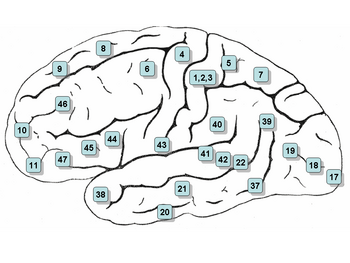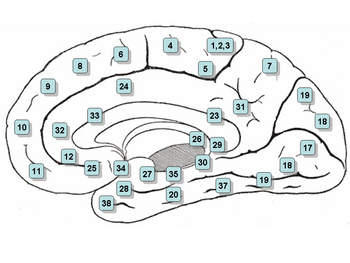(→Brodmann areas for human beings:: fix link) |
m (Brodmann area moved to Brodmann areas) |
||
| (4 intermediate revisions by one other user not shown) | |||
| Line 45: | Line 45: | ||
* [[Brodmann area 23|23]] - Ventral [[Posterior cingulate cortex]] |
* [[Brodmann area 23|23]] - Ventral [[Posterior cingulate cortex]] |
||
* [[Brodmann area 24|24]] - Ventral [[Anterior cingulate cortex]] |
* [[Brodmann area 24|24]] - Ventral [[Anterior cingulate cortex]] |
||
| − | * [[Brodmann area 25|25]] - [[ |
+ | * [[Brodmann area 25|25]] - [[Cingulate cortex| Subgenual cortex]] |
| − | * [[Brodmann area 26|26]] - [[Ectosplenial area]] |
+ | * [[Brodmann area 26|26]] - [[Brodmann area 26| Ectosplenial area]] |
* [[Brodmann area 28|28]] - Posterior [[Entorhinal Cortex]] |
* [[Brodmann area 28|28]] - Posterior [[Entorhinal Cortex]] |
||
* [[Brodmann area 29|29]] - Retrosplenial cingular cortex |
* [[Brodmann area 29|29]] - Retrosplenial cingular cortex |
||
| Line 72: | Line 72: | ||
== Criticism == |
== Criticism == |
||
When von Bonin and Bailey were to construct a brain map for the [[macaque]] monkey they found the description of Brodmann inadequate and wrote: |
When von Bonin and Bailey were to construct a brain map for the [[macaque]] monkey they found the description of Brodmann inadequate and wrote: |
||
| − | : ''Brodmann (1907), it is true, prepared a map of the human brain which has been widely reproduced, but, unfortunately, the data on which it was based was never published''<ref>Gerhardt von Bonin, Percival Bailey, ''The Neocortex of Macaca Mulatta'', |
+ | : ''Brodmann (1907), it is true, prepared a map of the human brain which has been widely reproduced, but, unfortunately, the data on which it was based was never published''<ref>Gerhardt von Bonin, Percival Bailey, ''The Neocortex of Macaca Mulatta'', The University of Illinois Press, Urbana, Illinois, 1925.</ref> |
They instead used the cytoarchitechtonic scheme of [[Economo]] and [[Koskinas]] published in 1925 which had the "only acceptable detailed description of the human cortex". |
They instead used the cytoarchitechtonic scheme of [[Economo]] and [[Koskinas]] published in 1925 which had the "only acceptable detailed description of the human cortex". |
||
| Line 93: | Line 93: | ||
[[Category:Cerebrum]] |
[[Category:Cerebrum]] |
||
[[Category:Neuroanatomy]] |
[[Category:Neuroanatomy]] |
||
| − | |||
| − | |||
| − | :fr:Aires de Brodmann |
||
| − | :id:Area Brodmann |
||
| − | :ja:ブロードマンの脳地図 |
||
| − | :sv:Brodmannarea |
||
| − | :zh:Brodmann分区系统 |
||
| − | {{enWP|Brodmann area}} |
||
Latest revision as of 21:57, 8 April 2008
Assessment |
Biopsychology |
Comparative |
Cognitive |
Developmental |
Language |
Individual differences |
Personality |
Philosophy |
Social |
Methods |
Statistics |
Clinical |
Educational |
Industrial |
Professional items |
World psychology |
Biological: Behavioural genetics · Evolutionary psychology · Neuroanatomy · Neurochemistry · Neuroendocrinology · Neuroscience · Psychoneuroimmunology · Physiological Psychology · Psychopharmacology (Index, Outline)
| Brain: Brodmann areas | ||
|---|---|---|
| Lateral surface. | ||
| Medial surface. | ||
| Latin | ' | |
| Gray's | subject # | |
| Part of | ||
| Components | ||
| Artery | ||
| Vein | ||
| BrainInfo/UW | ancil-410 | |
| MeSH | [1] | |
A Brodmann area is a region in the brain cortex defined in many different species based on its cytoarchitecture. Cytoarchitecture is the organization of the cortex as observed when a tissue is stained for nerve cells.
Brodmann areas were originally defined by Korbinian Brodmann and referred to by numbers from 1 to 52. Some of the original areas have been subdivided further and referred to, e.g., as "23a" and "23b". The same number in different species does not necessarily represent structurally homologous areas.
Brodmann areas for human beings:
- 1, 2 & 3 - Primary Somatosensory Cortex (frequently referred to as Areas 3, 1, 2 by convention)
- 4 - Primary Motor Cortex
- 5 - Somatosensory Association Cortex
- 6 - Pre-Motor and Supplementary Motor Cortex
- 7 - Somatosensory Association Cortex
- 8 - Includes Frontal Eye Field
- 9 - Dorsolateral prefrontal cortex
- 10 - Frontopolar area (most rostral part of superior and middle frontal gyri)
- 11 - Orbitofrontal area (orbital and rectus gyri, plus part of the rostral part of the superior frontal gyrus)
- 12 - Orbitofrontal area (used to be part of BA11, refers to the area between the superior frontal gyrus and the inferior rostral sulcus)
- 13 and 14* - Insular cortex
- 15* - Anterior Temporal Lobe
- 17 - Primary Visual Cortex (V1)
- 18 - Visual Association Cortex (V2)
- 19 - V3
- 20 - Inferior Temporal gyrus
- 21 - Middle Temporal gyrus
- 22 - Superior Temporal Gyrus, of which the rostral part participates to Wernicke's area
- 23 - Ventral Posterior cingulate cortex
- 24 - Ventral Anterior cingulate cortex
- 25 - Subgenual cortex
- 26 - Ectosplenial area
- 28 - Posterior Entorhinal Cortex
- 29 - Retrosplenial cingular cortex
- 30 - Part of cingular cortex
- 31 - Dorsal Posterior cingular cortex
- 32 - Dorsal anterior cingulate cortex
- 34 - Anterior Entorhinal Cortex (on the Parahippocampal gyrus)
- 35 - Perirhinal Cortex (on the Parahippocampal gyrus)
- 36 - Parahippocampal cortex (on the Parahippocampal gyrus)
- 37 - Fusiform gyrus
- 38 - Temporopolar area (most rostral part of the superior and middle temporal gyri
- 39 - Angular gyrus, part of Wernicke's area
- 40 - Supramarginal gyrus part of Wernicke's area
- 41 & 42 - Primary and Auditory Association Cortex
- 43 - Subcentral area (between insula and post/precentral gyrus)
- 44 - pars opercularis, part of Broca's area
- 45 - pars triangularis Broca's area
- 46 - Dorsolateral prefrontal cortex
- 47 - Inferior prefrontal gyrus
- 48 - Retrosubicular area (a small part of the medial surface of the temporal lobe)
- 52 - Parainsular area (at the junction of the temporal lobe and the insula)
(*) Area only found in non-human primates.
Criticism
When von Bonin and Bailey were to construct a brain map for the macaque monkey they found the description of Brodmann inadequate and wrote:
- Brodmann (1907), it is true, prepared a map of the human brain which has been widely reproduced, but, unfortunately, the data on which it was based was never published[1]
They instead used the cytoarchitechtonic scheme of Economo and Koskinas published in 1925 which had the "only acceptable detailed description of the human cortex".
See also
References
- ↑ Gerhardt von Bonin, Percival Bailey, The Neocortex of Macaca Mulatta, The University of Illinois Press, Urbana, Illinois, 1925.
External links
- brodmann x func — Functional categorization of Brodmann areas.
- Brodmann, Mark Dubin pages on Brodmann areas.
- Brodmann areas of cortex involved in language

